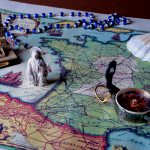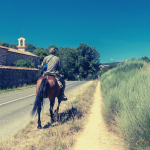SOME STOPS.

The Camino de Santiago is a wonderful, life-changing experience. There are so many highlights along the way that it’s impossible to choose a few. From Asturias to La Rioja to Castilla y León, the spiderweb of Ways encompasses the whole of Spain and much of Europe, so whichever path you take there’s sure to be innumerable treasures waiting to be discovered.
O Cebreiro, Galicia – The Original Way.
O Cebreiro is a gem of a village hidden up in the Galician mountains. In winter the snow can reach incredible heights, while in summer the panoramic views of the mountains will make the uphill trek worthwhile. The pallozas (round stone houses) date back to Celtic times, and it’s like you’re travelling back in time.
Roncesvalles, Navarre – The French Way.
Roncesvalles is the first resting stop after crossing the French Pyrenees. It’s particularly famous for being the site of a crushing defeat of the Frankish emperor Charlemagne, where he was beaten by Basque forces. The 13th-century church is well worth a visit, as is the beautiful monastery, where monks welcomed pilgrims with legendary hospitality. Stories say that this monastery was almost as important a resting place for pilgrims of old as Santiago itself.
Burgos, Castilla y Léon – The French Way.
As with so many stops on this list, the cathedral at Burgos is one of the finest in Spain. A Gothic masterpiece, it looms over this medieval city. You can also find the legendary El Cid buried under the cathedral if you’re interested in Spanish history, while the city itself is a labyrinth of winding streets and imposing medieval architecture.
Oviedo, Asturias – The Original Way.
Oviedo is the capital of the province of Asturias, and medieval architecture dominates its skyline. It’s the starting point of El Camino Primitivo, as travelling pilgrims are reminded that they’re are taking the same route as King Alfonso II in the 9th century. Wander along the brightly coloured streets or visit Oviedo Cathedral if you need a bit of breathing space before embarking on the first leg of your journey. You probably won’t be looking for somewhere to stay as you’ll start your journey from here.
Sarria, Galicia – The French Way.
Sarria is a popular starting point for pilgrims who don’t want to trek all the way across the Pyrenees; being a decently sized town there’s the opportunity for social contact before diving into the self-discovery that the Camino demands. The town is well-known for its beautiful array of ancient churches, so if starting from here, it’s a good indicator of what you’ll be treated to along the way.
Puebla de Sanabria, Castilla y León – The Silver Way.
This village is a stop on the Silver Way, which winds through North Africa and Andalusia before stopping in Santiago de Compostela. Preserving most of its historic walls, the town provides fantastic views over the surrounding countryside. An ancient church and castle complete the peaceful, medieval feel of the town.
Lugo, Galicia – The Original Way.
Packed full of history, this town is famous for its Roman Wall. One of the final major stopping points on the oldest camino, the Camino Primitivo, the city has managed to preserve much of its ancient history, including the remains of a Roman town underneath Lugo itself. It’s also one of the biggest cities in Galicia with a beautiful cathedral.
Santo Domingo de la Calzada, La Rioja – The French Way.
Located in the La Rioja region of Spain on the third leg of the Camino Francés, this picturesque village is the home of the more bizarre myths on the Iberian Peninsula. Supposedly, a man due to be hanged that day was reprieved when the two (roast) chickens on the mayor’s plate started cawing – and to this day, the symbol of the town is a chicken. The town is also named after Santo Domingo, who dedicated himself to improving conditions for pilgrims along the Way – stop here as you’re soaking up the beautiful, fertile countryside of La Rioja.
Santiago de Compostela, Galicia.
Through all the blisters, friends, and shared experiences, seeing the Cathedral in all its glory will make all the physical pain worth it. There’s so much history and culture to explore, with quaint cobbled side streets, endless museums and lots of nightclubs too, as it’s home to one of the most prestigious universities in Spain. Santiago is one of the most historic and peaceful cities in Spain, so you can enjoy it on the completion of your journey.
Written by theculturetrip.com
Highly recommended by HOSTAL GAU TXORI: comfortable accommodation, nice and traditional food and a wonderful natural landscape in Zubiri. Are you going to miss this stop?



